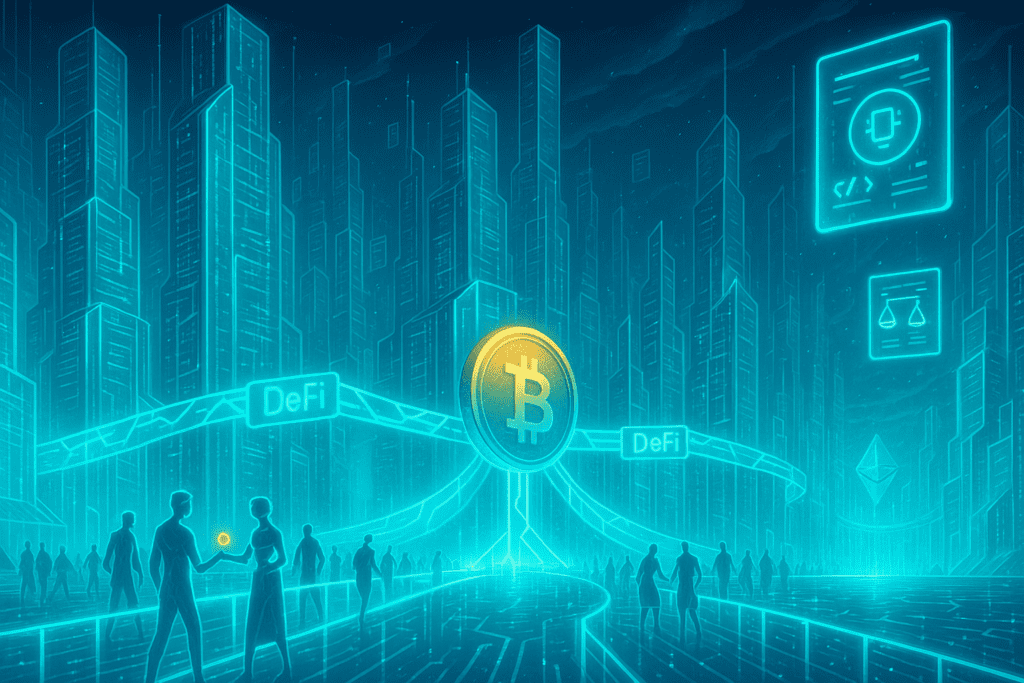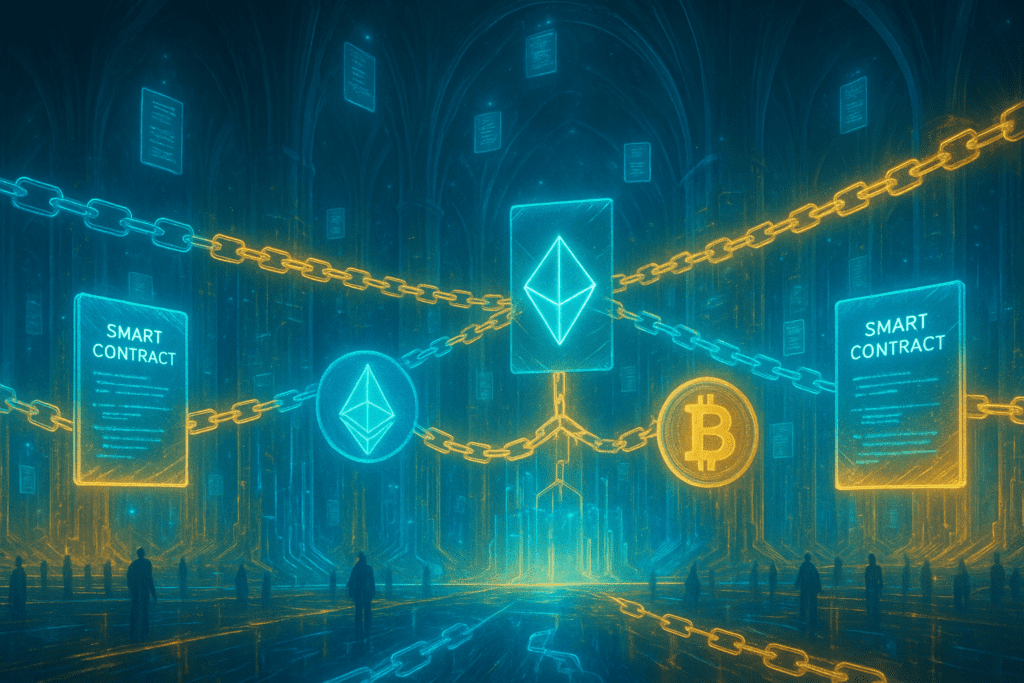DeFi explained for beginners — learn what decentralized finance is, how it works, and why it’s reshaping the global financial system.
📘 Table of Contents
- Introduction: The Rise of Decentralized Finance
- What Is DeFi?
- How DeFi Differs from Traditional Finance
- Core Components of the DeFi Ecosystem
- Key Technologies Behind DeFi
- Popular DeFi Platforms and Protocols
- DeFi Use Cases: What You Can Actually Do
- Risks, Challenges, and How to Stay Safe
- DeFi and Regulation: The Global Debate
- The Future of DeFi in 2025 and Beyond
- Conclusion: Why DeFi Matters
Online advertising service 1lx.online
Introduction: The Rise of Decentralized Finance
In the early days of cryptocurrency, Bitcoin was designed as “peer-to-peer electronic cash.” But the next big leap—DeFi (Decentralized Finance)—transformed that simple idea into an entire financial ecosystem without banks.
DeFi allows anyone with an internet connection to borrow, lend, trade, earn interest, and manage assets directly on the blockchain—no intermediaries, no waiting, no permissions.
“DeFi is the financial system re-engineered for a borderless digital world.”
It’s open, transparent, and driven entirely by smart contracts instead of paperwork.
What Is DeFi?
DeFi, short for Decentralized Finance, refers to a collection of financial applications built on blockchain networks—mainly Ethereum—that replace traditional financial intermediaries with code.
In DeFi, smart contracts execute automatically when conditions are met. That means:
- No banks approving loans.
- No brokers taking fees.
- No governments freezing funds.
Online advertising service 1lx.online
Instead, users interact directly with decentralized apps (dApps).
“If traditional finance runs on trust in institutions, DeFi runs on trust in mathematics.”

How DeFi Differs from Traditional Finance
| Feature | Traditional Finance | Decentralized Finance (DeFi) |
|---|---|---|
| Control | Centralized (banks) | Decentralized (users) |
| Accessibility | Requires ID & account | Open to anyone, anywhere |
| Transparency | Closed systems | Fully public blockchain |
| Speed | Slow, limited hours | 24/7 instant transactions |
| Intermediaries | Many | None |
| Custody | Held by bank | Held by user’s wallet |
Online advertising service 1lx.online
DeFi flips the model: you become your own bank.
Instead of relying on institutions, trust shifts to blockchain protocols—verifiable, auditable, and open-source.
Core Components of the DeFi Ecosystem
DeFi isn’t a single app—it’s a network of interlocking services that work together.
🔹 1. Decentralized Exchanges (DEXs)
Platforms such as Uniswap, PancakeSwap, and 1inch allow users to trade tokens directly from their wallets. Liquidity pools replace traditional order books.
🔹 2. Lending & Borrowing Platforms
Protocols like Aave or Compound let users lend crypto to earn interest or borrow against collateral instantly.
🔹 3. Stablecoins
Tokens such as USDT, USDC, and DAI keep DeFi stable by maintaining a 1:1 peg to fiat currencies.
🔹 4. Yield Farming & Staking
Users earn passive income by providing liquidity or staking assets to secure networks.
🔹 5. DeFi Insurance & Derivatives
Projects like Nexus Mutual protect users against smart-contract failures. Synthetic platforms create on-chain versions of stocks or commodities.
Key Technologies Behind DeFi
- Smart Contracts: Self-executing programs that remove intermediaries.
- Oracles: Connect blockchain data to real-world information (e.g., prices).
- Layer-2 Scaling: Networks like Arbitrum and Optimism make DeFi faster and cheaper.
- Cross-Chain Bridges: Allow assets to move between ecosystems like Bitcoin ↔ Ethereum ↔ TON.
- Non-Custodial Wallets: MetaMask or TON Wallet put full control in users’ hands.
Together, these technologies make decentralized finance secure, transparent, and accessible.

Popular DeFi Platforms and Protocols
| Category | Examples | Description |
|---|---|---|
| DEX | Uniswap, Curve, PancakeSwap | Token swaps and liquidity pools |
| Lending | Aave, Compound, Venus | Earn or borrow crypto |
| Derivatives | Synthetix, GMX | Trade synthetic assets |
| Stablecoins | DAI, USDC, FRAX | Pegged to fiat |
| Aggregators | Yearn Finance, 1inch | Optimize yields & trades |
Newer entrants like TON DeFi and LayerZero-powered bridges extend interoperability into Telegram-based ecosystems.
DeFi Use Cases: What You Can Actually Do
1. Earn Passive Income – Deposit tokens into liquidity pools to collect trading fees or yield.
2. Borrow Without Banks – Use your crypto as collateral for instant loans.
3. Tokenize Assets – Represent real-world property or stocks on-chain.
4. Trade 24/7 – Swap tokens anytime, anywhere.
5. Fund Projects – Participate in decentralized launchpads (IDOs).
“In DeFi, your money never sleeps—it works for you on-chain.”
Risks, Challenges, and How to Stay Safe
DeFi’s openness brings both opportunity and danger.
⚠️ Common Risks:
- Smart Contract Bugs: Code exploits can drain funds.
- Impermanent Loss: LPs may lose value when prices fluctuate.
- Rug Pulls: Anonymous teams disappearing with investor money.
- Regulatory Uncertainty: Laws vary across countries.
🛡️ Safety Tips:
- Verify audits.
- Use trusted wallets.
- Avoid projects promising unrealistic returns.
- Diversify across platforms.
DeFi and Regulation: The Global Debate
Governments are still deciding how to regulate DeFi. Unlike centralized exchanges, there’s no CEO to subpoena.
- U.S. SEC seeks frameworks for DeFi securities.
- EU MiCA Regulation may extend oversight to DeFi tokens.
- Asia (Pacific & Singapore) encourages innovation under sandbox rules.
Regulation aims to protect investors without killing innovation—a delicate balance.
“DeFi challenges not only finance—but the very idea of who controls money.”

The Future of DeFi in 2025 and Beyond
DeFi continues evolving rapidly. Trends shaping its next era:
- Real-World Assets (RWA): Tokenized property, invoices, and art entering DeFi.
- Interoperability: Seamless swaps between ecosystems (Ethereum ↔ TON ↔ Solana).
- AI + DeFi Automation: Smart algorithms managing yield and risk.
- Mobile DeFi: Telegram Mini-Apps and TON Wallet make access effortless.
- Institutional Adoption: Banks exploring regulated DeFi pools.
Analysts forecast DeFi total value locked (TVL) could surpass $500 billion by 2030—becoming a parallel global economy.
Conclusion: Why DeFi Matters
DeFi is more than a trend—it’s a revolution in how money works.
It empowers individuals, removes barriers, and redefines trust. Whether you’re a trader, developer, or everyday user, understanding DeFi is essential for navigating the digital future.
“Decentralized Finance isn’t just the future of crypto—it’s the future of finance itself.”
Our creator. creates amazing NFT collections!
Support the editors - Bitcoin_Man (ETH) / Bitcoin_Man (TON)
Pi Network (Guide)is a new digital currency developed by Stanford PhDs with over 55 million participants worldwide. To get your Pi, follow this link https://minepi.com/Tsybko and use my username (Tsybko) as the invite code.
Binance: Use this link to sign up and get $100 free and 10% off your first months Binance Futures fees (Terms and Conditions).
Bitget: Use this link Use the Rewards Center and win up to 5027 USDT!(Review)
Bybit: Use this link (all possible discounts on commissions and bonuses up to $30,030 included) If you register through the application, then at the time of registration simply enter in the reference: WB8XZ4 - (manual)
